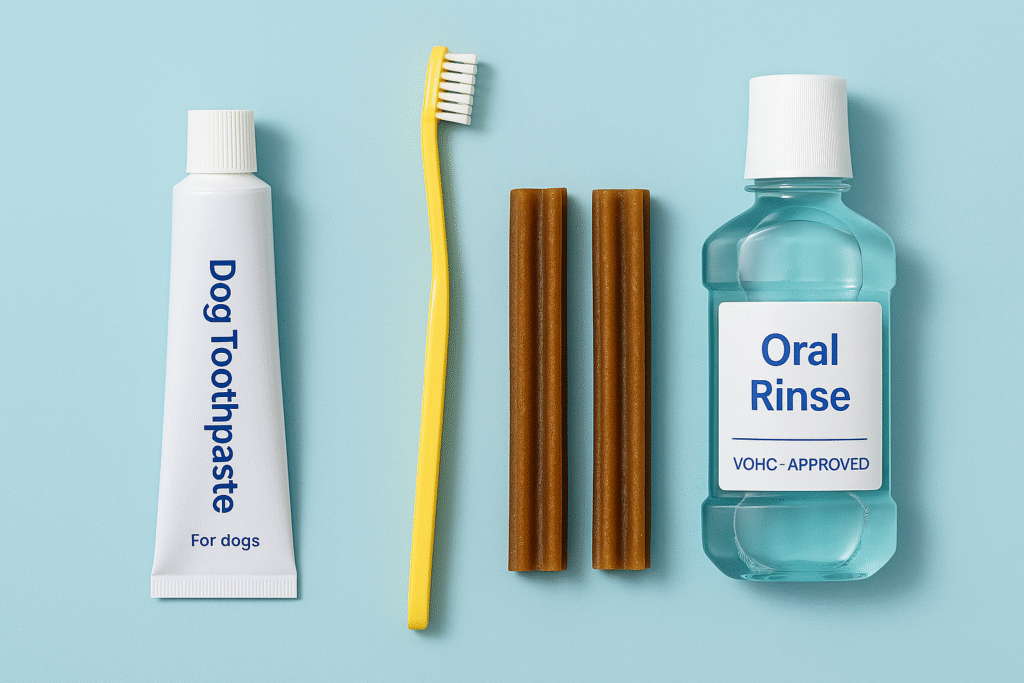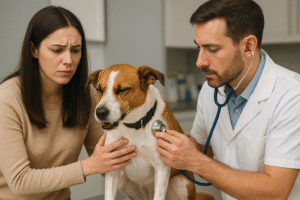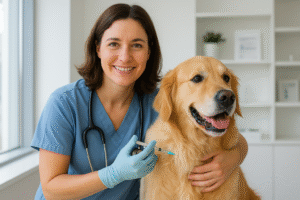Medical Disclaimer: This article is for informational purposes only and does not replace professional veterinary advice. Always consult your veterinarian for personalized recommendations.
Canine periodontal disease is one of the most common—and most overlooked—health issues in dogs, affecting nearly 80% of pups over the age of three. The trouble is, many pet owners don’t catch it until the damage is already done: loose teeth, swollen gums, or a dog suddenly reluctant to eat. As a veterinarian, I’ve seen just how quietly this disease can progress, and just how transformative early dental care can be. It’s not just about saving teeth—it’s about protecting your dog’s comfort, and in many cases, their heart and kidneys, too.
In this article, I’ll break down what actually works when it comes to keeping your dog’s mouth healthy. We’ll cut through the noise, focus on the proven methods—from daily brushing routines to professional dental cleanings—and help you recognize the early signs before they become serious. All recommendations align with the most up-to-date veterinary dental guidelines (WSAVA, 2021), so you can feel confident you’re doing what’s best for your dog.
Table of Contents
🔑 Key Takeaways: Canine Periodontal Disease at a Glance
- Canine periodontal disease is one of the most common health problems in adult dogs—affecting up to 100% in some studies when examined under anesthesia.
- Early signs are easy to miss. Many dogs with advanced disease still eat and act usually.
- This condition doesn’t just affect the mouth. Chronic infection can impact the heart, liver, and kidneys, and may worsen inflammatory conditions (PubMed, 1998).
- The best prevention? Daily home care (like brushing or dental chews) combined with routine professional cleanings at your veterinarian.
- Small-breed dogs, seniors, and flat-faced breeds are at higher risk and may need more frequent monitoring.

What Is Canine Periodontal Disease?
Canine periodontal disease is a progressive infection of the tissues that support your dog’s teeth—starting with the gums and advancing deeper into the bone and ligaments. It begins when plaque (a sticky bacterial film) hardens into tartar, triggering gum inflammation called gingivitis. Without treatment, this progresses to periodontitis, where infection and inflammation cause irreversible bone loss and eventually tooth loss.
From Plaque to Tooth Loss: What Happens
- Plaque formation begins within hours after eating.
- Tartar buildup calcifies on the teeth in days.
- Gingivitis sets in—marked by red, swollen gums that bleed easily.
- Periodontitis causes deeper pockets around teeth, loosening and bone erosion.
- Tooth loss or infection spreads to other areas of the body.
The 4 Stages of Periodontal Disease in Dogs
| Stage | Description | Reversible? | Signs You May Notice |
| 1 | Mild gingivitis | Yes | Red gums, slight odor |
| 2 | Early periodontitis | Partially | Gum recession, tartar |
| 3 | Moderate periodontitis | No | Loose teeth, bleeding |
| 4 | Advanced periodontitis | No | Pain, pus, tooth loss |
According to the WSAVA Dental Guidelines, once periodontal disease reaches stage 3 or 4, only professional veterinary intervention under anesthesia can stop its progression (WSAVA, 2021).
How Common Is Canine Periodontal Disease?
Despite its impact, canine periodontal disease is severely underdiagnosed—especially in routine exams where dogs are awake. In my own practice, I often spot mild tartar and gingivitis during checkups, but the true extent becomes clear only under anesthesia with proper probing and dental radiographs.
Alarming Statistics Every Dog Owner Should Know
- 9–18% of dogs are diagnosed with periodontal disease during regular wellness exams.
- When examined under anesthesia, the actual prevalence jumps to 44–100%, depending on age and breed (ResearchGate, 2020).
That’s a staggering gap—and it highlights why this disease is often called “silent.”

Why Awake Exams Miss Most Cases
Dogs naturally mask pain and discomfort, making dental problems harder to detect. Without sedation:
- Vets can’t probe below the gumline, where most damage occurs.
- X-rays are not possible in awake pets, hiding root damage or abscesses.
That’s why yearly dental exams under anesthesia are the gold standard for detecting and staging this disease.
High-Risk Breeds and Ages
Certain dogs are genetically or physically predisposed to dog gum disease:
- Small breeds: Yorkies, Chihuahuas, Dachshunds, and Toy Poodles often show signs earlier due to crowded teeth.
- Flat-faced (brachycephalic) breeds: Bulldogs and Shih Tzus may suffer due to abnormal tooth alignment.
- Older dogs (ages 5+): The risk increases sharply with age, especially if dental care has been inconsistent.
7 Proven Prevention Strategies for Dog Gum Health
You can prevent or slow canine periodontal disease with a daily routine and routine veterinary care. The earlier you start—ideally in puppyhood—the better your dog’s long-term dental and systemic health will be.
1. Daily Toothbrushing with Dog Toothpaste
Brushing is still the #1 most effective way to prevent plaque and tartar buildup. Use a soft-bristled brush and enzymatic dog toothpaste—never human toothpaste, which can be toxic. Aim for daily brushing, or at minimum 3–4 times a week.
2. Vet-Approved Dental Chews and Treats
Look for products approved by the Veterinary Oral Health Council (VOHC), which test for actual plaque and tartar reduction. These chews help scrape teeth mechanically and may include enzymes or antimicrobial agents. Examples: Greenies™, Virbac® C.E.T. chews.
3. Prescription Dental Diets for Tartar Control
Some veterinary diets use special kibble texture or active ingredients like sodium hexametaphosphate to reduce tartar. Brands like Hill’s® t/d or Royal Canin® Dental are clinically proven to help with ongoing plaque control (ScienceDirect, 2022).
4. Antiseptic Oral Rinses or Gels
Chlorhexidine-based rinses or gels can reduce bacteria in the mouth, especially in dogs that resist brushing. These are helpful in between cleanings or during recovery from dental procedures.
5. Annual Professional Cleanings (Under Anesthesia)
Your vet can clean beneath the gumline, extract diseased teeth, and take dental x-rays—all impossible in awake pets. This step is essential for dogs showing signs of periodontal infection.
6. X-rays to Detect Hidden Infection
Dental radiographs reveal what the eye can’t see—root abscesses, jawbone loss, and hidden pockets of infection. The WSAVA recommends x-rays as standard for all dental patients (WSAVA, 2021).
7. Routine Vet Checks for Early Signs
Your vet will monitor gum color, tartar buildup, tooth mobility, and signs of oral pain. Dogs with prior disease or at-risk breeds may need exams every 6 months.
Canine Periodontal Disease and Whole-Body Health
Many dog owners are surprised to learn that canine periodontal disease isn’t just about teeth—it can have ripple effects throughout your pet’s body. Chronic inflammation in the mouth allows bacteria to enter the bloodstream, potentially damaging internal organs over time.
The Link Between Gum Infections and Organ Damage
Research shows that bacteremia—bacteria circulating in the blood—can result from periodontal infections in dogs. These microbes may lodge in organs like the:

- Heart – contributing to endocarditis, especially in older or at-risk dogs.
- Kidneys – chronic inflammation may worsen renal disease.
- Liver – affected by circulating toxins and inflammatory signals.
- Lungs – inhalation of bacteria during dental procedures or due to oral infections may increase pneumonia risk (Vet Clinics Review, 2021).
Immune and Inflammatory Impacts
Systemic inflammation triggered by oral bacteria doesn’t just affect organs—it can worsen existing conditions like diabetes, immune-mediated disorders, and even arthritis. Just like in people, managing oral health is a key part of managing overall wellness in dogs.
That’s why the Canadian Veterinary Medical Association emphasizes dental care as part of routine wellness, not just cosmetic cleaning (CVMA).
5-Minute Home Checklist for Dog Dental Health
Want a quick way to stay ahead of canine periodontal disease? This easy checklist can help you monitor your dog’s oral health in just minutes a day. Print it out or bookmark it—consistency is key!
✅ Daily or Weekly Checks
| Task | What to Look For |
| 1. Smell their breath | Is it sour, fishy, or unusually strong? |
| 2. Lift their lips | Any red gums, visible tartar, or swelling? |
| 3. Check eating behavior | Slower chewing, food dropping, reluctance to eat? |
| 4. Brush or offer dental chew | Track consistency, aim for daily care. |
| 5. Log last vet dental visit | Has it been more than 12 months? |
Bonus Tip
Use a weekly dental tracker app or dry-erase board to record when you brush or give dental chews—this builds long-term habits and helps your vet track progress.

By checking these simple signs, you may catch periodontal issues before they become painful or expensive. Early detection saves money—and protects your dog’s quality of life.
Cost of Dental Cleanings in Canada
Professional cleanings are the cornerstone of preventing advanced canine periodontal disease, but many owners are unsure what to expect cost-wise. While prices vary by clinic, province, and dog size, here’s a general breakdown.
Typical Canadian Veterinary Dental Cleaning Costs (2025)
| Procedure | Small Dog (≤10 kg) | Medium Dog (10–25 kg) | Large Dog (25+ kg) |
| Pre-anesthetic bloodwork | $90–$150 | $90–$150 | $90–$150 |
| Full dental under anesthesia | $500–$900 | $600–$1,000 | $700–$1,200 |
| Dental radiographs (full mouth) | $150–$300 | $150–$300 | $150–$300 |
| Extractions (per tooth) | $50–$150 | $50–$150 | $50–$150 |
| Total estimate (with x-rays, no extractions) | $700–$1,200 | $800–$1,300 | $900–$1,500 |
🐾 Note: Some pet insurance plans may cover dental cleanings or extractions if deemed medically necessary. Ask your vet about dental packages that include cleaning, x-rays, and bloodwork at a bundled rate.
Why It’s Worth It
Treating late-stage periodontal disease in dogs often involves costly surgery, tooth removal, and post-op meds. A yearly cleaning, while not cheap, can prevent much more serious problems—and pain—for your pet.
Frequently Asked Questions About Canine Periodontal Disease
1. What are the first signs of canine periodontal disease?
Bad breath is often the earliest sign. You may also notice red gums, yellow or brown tartar, drooling, or pawing at the mouth. Many dogs won’t show pain until the disease is advanced.
2. Can canine periodontal disease shorten my dog’s life?
Yes. Research suggests that chronic gum infections can lead to systemic inflammation and damage organs like the heart and kidneys, potentially shortening lifespan (PubMed, 1998).
3. Is brushing better than giving dental chews?
Absolutely. Brushing removes plaque before it hardens into tartar. Dental chews help, but brushing is still the most effective form of home care (ScienceDirect, 2022).
4. What toothpaste is safe for dogs?
Only use toothpaste made specifically for pets. Human toothpaste can contain xylitol or fluoride, which are toxic to dogs. Look for veterinary brands with enzymes like glucose oxidase or lactoperoxidase.
5. Are anesthesia-free dental cleanings safe?
No. These cleanings can’t reach below the gumline or detect deep disease. The WSAVA strongly discourages them, as they may give a false sense of security while the infection worsens unseen.
Conclusion and Next Steps
Canine periodontal disease is common, progressive—and preventable. With daily care at home and regular veterinary support, you can dramatically reduce your dog’s risk of painful tooth loss, infection, and long-term health complications.
Here’s What You Can Do Today:
- Start brushing daily with pet-safe toothpaste.
- Book a dental exam with your vet, especially if it’s been over a year.
- Choose VOHC-approved chews or diets for maintenance.
- Track symptoms like bad breath or gum redness in a journal or app.
As a veterinarian, I can confidently say: no step is too small. What matters most is consistency. Protect your dog’s smile—and their heart, kidneys, and comfort—by making dental care part of your daily routine.




